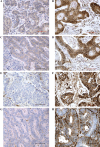The prognostic value of leucine-rich repeat-containing G-protein (Lgr5) and its impact on clinicopathological features of colorectal cancer
- PMID: 32671503
- PMCID: PMC7467967
- DOI: 10.1007/s00432-020-03314-7
The prognostic value of leucine-rich repeat-containing G-protein (Lgr5) and its impact on clinicopathological features of colorectal cancer
Abstract
Introduction: Colorectal cancer (CRC) constitutes one of the most prevalent malignancies in the world. Recent research suggests that cancer stem cells (CSCs) are responsible for tumor cell's malignant behavior in CRC. This study has been designed to determinate clinical implications of CSC markers: CD44, DCLK1, Lgr5, and ANXA2 in CRC.
Materials and methods: The study was performed on tissue samples which were collected from 89 patients undergoing colectomy. Formalin-fixed paraffin-embedded tissue blocks with representative tumor areas were identified and corded. Immunohistochemical staining was performed using anti-CD44, anti-LGR5, anti-ANXA2, and anti-DCLK1 antibodies. The H-score system was utilized to determine the immunointensity of CRC cells.
Results: The lower expression of Lgr5 was significantly correlated with the presence of lymph-node metastases (p = 0.011), while high expression of Lgr5 was statistically significant in vascular invasion in examined cancer tissue samples (p = 0.027). Moreover, a high H-score value of Lgr5 expression was significantly related to a reduced overall survival rate (p = 0.043).
Conclusion: Our results suggest a strong relationship between CSC marker Lgr5 and vascular invasion, presence of lymph-node metastasis, and overall poor survival. The presence of Lgr5 might be an unfavorable prognostic factor, and its high level in cancer tissue is related to an aggressive course. This marker could also be used to access the effectiveness of the treatment.
Keywords: ANAX2; CD44; CSC; Colorectal cancer; DCLK1; Lgr5.
Conflict of interest statement
The authors declare that they have no competing interests.
Figures





Similar articles
-
A new insight into cancer stem cell markers: Could local and circulating cancer stem cell markers correlate in colorectal cancer?Tumour Biol. 2016 Feb;37(2):2405-14. doi: 10.1007/s13277-015-3989-7. Epub 2015 Sep 17. Tumour Biol. 2016. PMID: 26383518
-
Upregulation of circulating cancer stem cell marker, DCLK1 but not Lgr5, in chemoradiotherapy-treated colorectal cancer patients.Tumour Biol. 2015 Jun;36(6):4801-10. doi: 10.1007/s13277-015-3132-9. Epub 2015 Jan 29. Tumour Biol. 2015. PMID: 25631749
-
Role of doublecortin-like kinase 1 and leucine-rich repeat-containing G-protein-coupled receptor 5 in patients with stage II/III colorectal cancer: Cancer progression and prognosis.World J Gastroenterol. 2020 Nov 21;26(43):6853-6866. doi: 10.3748/wjg.v26.i43.6853. World J Gastroenterol. 2020. PMID: 33268966 Free PMC article.
-
The Essential Role of DCLK1 in Pathogenesis, Diagnostic Procedures and Prognostic Stratification of Colorectal Cancer.Anticancer Res. 2019 Jun;39(6):2689-2697. doi: 10.21873/anticanres.13394. Anticancer Res. 2019. PMID: 31177103 Review.
-
Prognostic value of LGR5 in colorectal cancer: a meta-analysis.PLoS One. 2014 Sep 5;9(9):e107013. doi: 10.1371/journal.pone.0107013. eCollection 2014. PLoS One. 2014. PMID: 25192390 Free PMC article. Review.
Cited by
-
LGR5: An emerging therapeutic target for cancer metastasis and chemotherapy resistance.Cancer Metastasis Rev. 2025 Jan 17;44(1):23. doi: 10.1007/s10555-024-10239-x. Cancer Metastasis Rev. 2025. PMID: 39821694 Free PMC article. Review.
-
SPDL1 Is an Independent Predictor of Patient Outcome in Colorectal Cancer.Int J Mol Sci. 2022 Feb 5;23(3):1819. doi: 10.3390/ijms23031819. Int J Mol Sci. 2022. PMID: 35163739 Free PMC article.
-
Leucine-rich repeat-containing G protein-coupled receptor 5 expression in lymph node metastases of colorectal cancer: Clinicopathological insights and prognostic implications.Pathol Int. 2024 Jul;74(7):387-393. doi: 10.1111/pin.13439. Epub 2024 May 24. Pathol Int. 2024. PMID: 38787285 Free PMC article.
-
Diagnostic significance and carcinogenic mechanism of pan-cancer gene POU5F1 in liver hepatocellular carcinoma.Cancer Med. 2020 Dec;9(23):8782-8800. doi: 10.1002/cam4.3486. Epub 2020 Sep 26. Cancer Med. 2020. PMID: 32978904 Free PMC article.
-
Expression of 5-HT Relates to Stem Cell Marker LGR5 in Patients with Gastritis and Gastric Cancer.Dig Dis Sci. 2023 May;68(5):1864-1872. doi: 10.1007/s10620-022-07772-6. Epub 2022 Nov 27. Dig Dis Sci. 2023. PMID: 36436157 Free PMC article.
References
-
- Amin MB, Greene FL, Edge SB et al (2017) The Eighth Edition AJCC Cancer Staging Manual: continuing to build a bridge from a population-based to a more “personalized” approach to cancer staging. CA Cancer J Clin. 10.3322/caac.21388 - PubMed
-
- Boddupally K, Wang G, Chen Y, Kobielak A (2016) Lgr5 marks neural crest derived multipotent oral stromal stem cells. Stem Cells 34:720–731. 10.1002/stem.2314 - PubMed
MeSH terms
Substances
LinkOut - more resources
Full Text Sources
Medical
Miscellaneous

